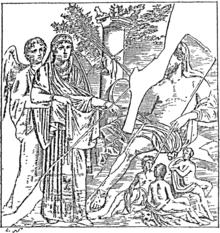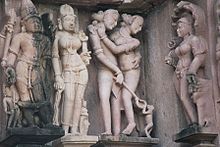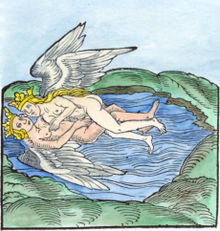- Hieros gamos
-
Hieros gamos or Hierogamy (Greek ἱερὸς γάμος, ἱερογαμία "holy marriage") refers to a sexual ritual that plays out a marriage between a god and a goddess, especially when enacted in a symbolic ritual where human participants represent the deities. It is the harmonization of opposites.[citation needed]
The notion of hieros gamos does not presuppose actual performance in ritual, but is also used in purely symbolic or mythological context, notably in alchemy and hence in Jungian psychology.
Contents
Hinduism
In Hinduism, Devadasi tradition (देवदासी / ದೇವದಾಸಿ; "servant of god") is a religious tradition in which girls are "married" and dedicated to a deity (deva or devi) or to a Hindu temple and includes performance aspects such as those that take place in the temple as well as in the courtly and mujuvani [telegu] or home context. Originally, in addition to this and taking care of the temple and performing rituals, these women learned and practiced Sadir, Odissi and other classical Indian artistic traditions and enjoyed a high social status. Though traditionally, they carry out dances in the praise of lord, they also evolved into Sacred Marriage over time.
Ancient Near East
Sacred prostitution was common in the Ancient Near East[1] as a form of "Sacred Marriage" or hieros gamos between the king of a Sumerian city-state and the High Priestess of Inanna, the Sumerian goddess of love, fertility, and warfare. Along the Tigris and Euphrates rivers there were many shrines and temples dedicated to Inanna. The temple of Eanna, meaning "house of heaven"[2] in Uruk[3] was the greatest of these. The temple housed priestesses of the goddess. The high priestess would choose for her bed a young man who represented the shepherd Dumuzid, consort of Inanna, in a hieros gamos or sacred marriage, celebrated during the annual Akitu (New Year) ceremony, at the spring Equinox.
In some cases, it served a practical purpose: since commoners frequently took this opportunity to have sex with their own spouses, it coordinated the births of children so that they would be born in the winter, when there was more time to take care of them.[4] Children born in midwinter of these unions were called the "son" or "daughter of god".
Greek mythology
In Greek mythology the classic instance is the wedding of Zeus and Hera celebrated at the Heraion of Samos,[5] and doubtless its architectural and cultural predecessors. Some scholars[6] would restrict the term to reenactments, but most accept is extension to real or simulated union in the promotion of fertility: such an ancient union of Demeter with Iasion, enacted in a thrice-plowed furrow, a primitive aspect of a sexually-active Demeter reported by Hesiod,[7] is sited in Crete, origin of much early Greek myth. In actual cultus, Walter Burkert found the Greek evidence "scanty and unclear": "To what extent such a sacred marriage was not just a way of viewing nature, but an act expressed or hinted at in ritual is difficult to say"[8] the best-known ritual example surviving in classical Greece is the hieros gamos enacted at the Anthesteria by the wife of the Archon basileus, the "Archon King" in Athens, originally therefore the queen of Athens, with Dionysus, presumably represented by his priest or the basileus himself, in the Boukoleion in the Agora.[9]
The brief fertilizing mystical union engenders Dionysus, and doubled unions, of a god and of a mortal man on one night, result, through telegony, in the semi-divine nature of Greek heroes such as Theseus and Heracles among others.
Tantric Buddhism
In Tantric Buddhism of India, Bhutan, Nepal and Tibet, yab-yum is a ritual of the male deity in union with his female consort. The symbolism is associated with Anuttarayoga tantra where the male figure is usually linked to compassion (karuṇā) and skillful means (upāya-kauśalya), and the female partner to 'insight' (prajñā).[10][11] Yab-yum is generally understood to represent the primordial (or mystical) union of wisdom and compassion.[12]
Maithuna is a Sanskrit term used in Tantra most often translated as sexual union in a ritual context. It is the most important of the five makara and constitutes the main part of the Grand Ritual of Tantra variously known as Panchamakara, Panchatattva, and Tattva Chakra.
The symbolism of union and polarity is a central teaching in Tantric Buddhism, especially in Tibet. The union is realized by the practitioner as a mystical experience within one's own body.
Alchemy and Jungian psychology
The hieros gamos is one of the themes that Carl Jung dealt with, in his book Symbols of Transformation.
Neopaganism
In Wicca, the Great Rite is a ritual based on the Hieros Gamos. It is generally enacted symbolically by a dagger being placed point first into a chalice, the action symbolizing the union of the male and female divine in the Hieros gamos. In British Traditional Wicca, the Great Rite is sometimes carried out in actuality by the High Priest and High Priestess.
See also
- Maithuna
- Spirit spouse (in dreams)
- Sacred prostitution
- Sex magic
- Tantra
References
- ^ James Frazer (1922), The Golden Bough, 3e, Chapter 31: Adonis in Cyprus
- ^ é-an-na = sanctuary ('house' + 'Heaven'[='An'] + genitive) [John Halloran's Sumerian Lexicon v. 3.0 -- see link below]
- ^ modern-day Warka, Biblical Erech
- ^ Larry Gonick (1990). The Cartoon History of the Universe: From the Big Bang to Alexander the Great. Doubleday, 368. ISBN 0-393-32403-6.
- ^ Walter Burkert warns that "the Hera festival is much too complicated tobe understood simply as Hera's wedding" (Burkert, Greek Religion, J. Raffan, tr. (Cambridge: Harvard University Press, 1985) §II.7.7 "Sacred Marriage" 108.
- ^ For example 'H. Sauer, in Der Kleine Pauly, s.v.
- ^ Hesiod, Theogony 969f.
- ^ Burkert 1985:108.
- ^ S.M. Kramer, The Sacred Marriage Rite (Bloomington:Indiana University Press, 1969); Karl Kerenyi, Zeus und Hera. Urbild des Vaters des Gatten und der Frau (Leiden:Brill 1972) 83-90.
- ^ Keown, Damien. (2003). A Dictionary of Buddhism, p. 338. Oxford University Press. ISBN 0-19-860560-9.
- ^ "Yab Yum Iconography and the Role of Women in Tibetan Tantric Buddhism." The Tibet Journal. Vol. XXII, No. 1. Spring 1997, pp. 12-34.
- ^ The Marriage of Wisdom and Method By Marco Pallis
External links
Categories:- Marriage
- Religious behaviour and experience
- Sexuality and religion
- Mythemes
- Greek loanwords
- Ancient Greek religion
Wikimedia Foundation. 2010.



